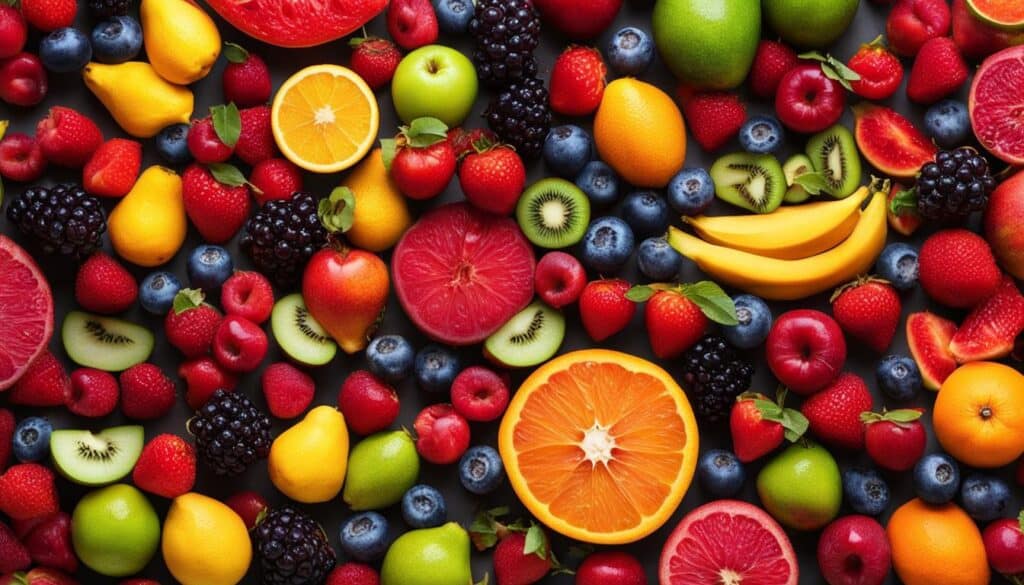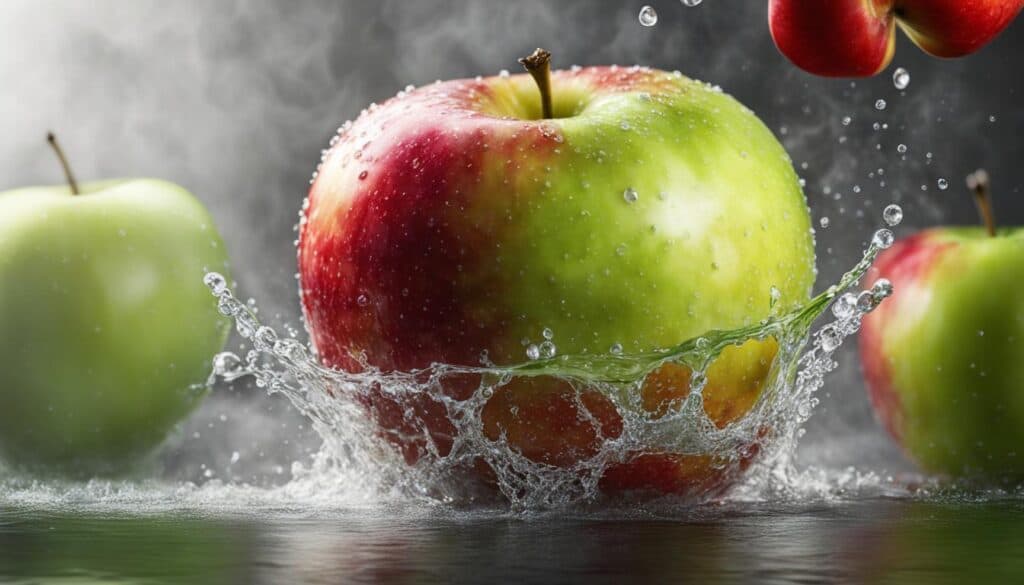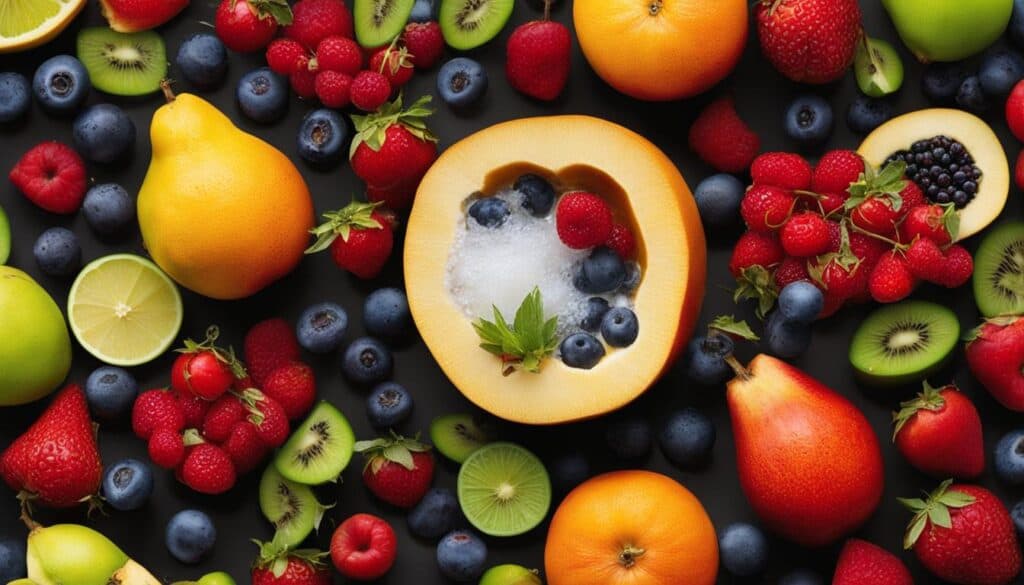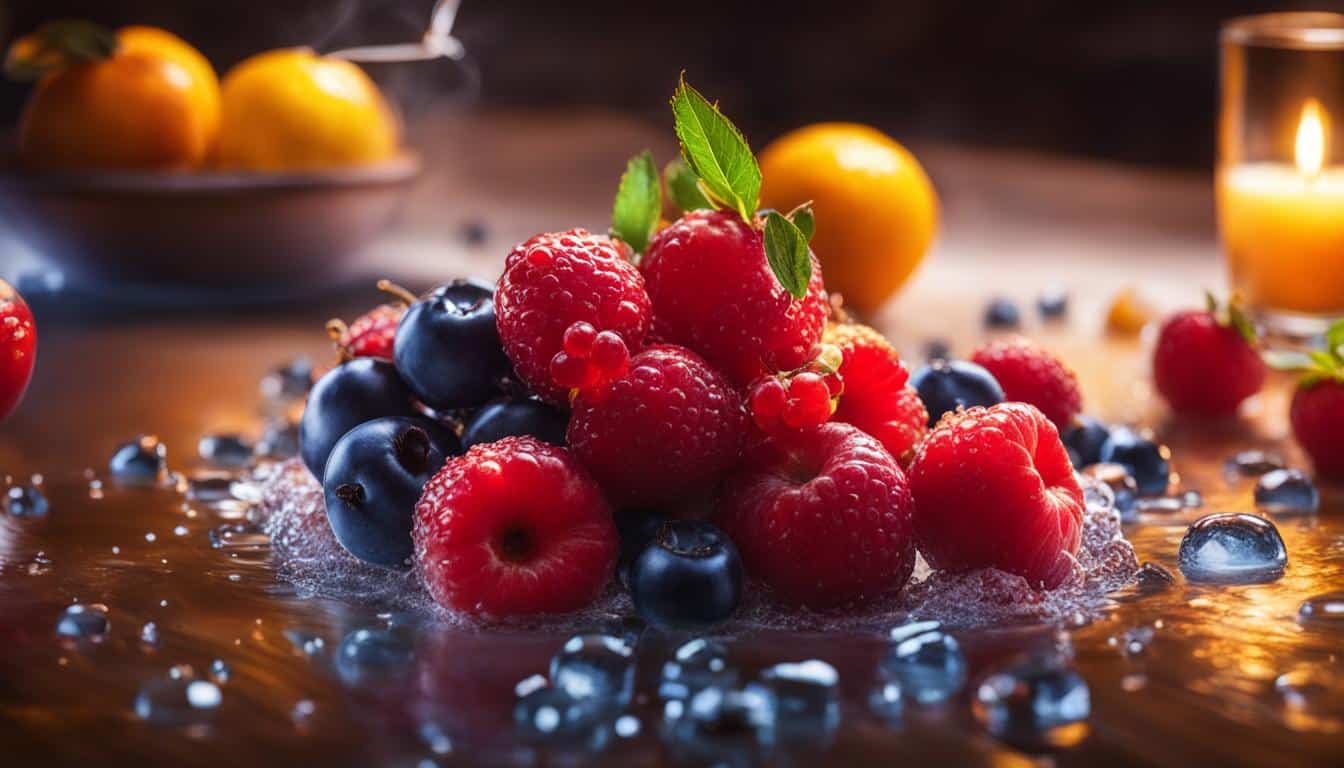Greetings, dear readers! Today, I am excited to dive into the topic of fruit wash and unravel its wonders. Have you ever wondered what fruit wash is and how it can benefit you? Well, you’ve come to the right place! Let’s explore the world of fruit wash together.
Key Takeaways:
- Fruit wash is a solution used to clean fruits and vegetables, ensuring they are safe to eat.
- It helps remove dirt, pesticides, and microbes that can be present on the surface of produce.
- Using fruit wash promotes food safety and contributes to maintaining the cleanliness and quality of fresh produce.
- Fruit wash can be in the form of commercial products, homemade recipes, or simple solutions like water.
- By incorporating fruit wash into your routine, you can enjoy the nutritional benefits of fruits and vegetables with peace of mind.
Why Should You Use Fruit Wash?
Using fruit wash offers numerous benefits that contribute to the safety and cleanliness of your produce. One of the primary advantages of using fruit wash is the ability to remove dirt, debris, and pesticide residues that may be present on the surface of fruits and vegetables. By washing your produce with fruit wash, you can significantly reduce your exposure to potentially harmful substances and promote better health.
Furthermore, fruit washes can effectively eliminate bacteria, viruses, and other pathogens that may be present on fresh produce. This helps to minimize the risk of foodborne illnesses and ensures that your fruits and vegetables are safe for consumption. It is especially important to use fruit wash for produce that is likely to have higher pesticide residues, such as conventionally grown fruits and vegetables.
In summary, using fruit wash is a simple yet effective practice that can enhance the cleanliness and safety of your fresh produce. It helps to remove dirt, debris, pesticide residues, and harmful microorganisms, reducing the risk of foodborne illnesses and promoting better health.
Why Should You Use Fruit Wash?
Using fruit wash offers numerous benefits that contribute to the safety and cleanliness of your produce. One of the primary advantages of using fruit wash is the ability to remove dirt, debris, and pesticide residues that may be present on the surface of fruits and vegetables. By washing your produce with fruit wash, you can significantly reduce your exposure to potentially harmful substances and promote better health.
“Using fruit wash is a simple yet effective practice that can enhance the cleanliness and safety of your fresh produce.”
Furthermore, fruit washes can effectively eliminate bacteria, viruses, and other pathogens that may be present on fresh produce. This helps to minimize the risk of foodborne illnesses and ensures that your fruits and vegetables are safe for consumption. It is especially important to use fruit wash for produce that is likely to have higher pesticide residues, such as conventionally grown fruits and vegetables.
In summary, using fruit wash is a simple yet effective practice that can enhance the cleanliness and safety of your fresh produce. It helps to remove dirt, debris, pesticide residues, and harmful microorganisms, reducing the risk of foodborne illnesses and promoting better health.
Why Should You Use Fruit Wash?
- Removes dirt, debris, and pesticide residues from fruits and vegetables
- Reduces exposure to potentially harmful substances
- Eliminates bacteria, viruses, and other pathogens
- Minimizes the risk of foodborne illnesses
- Especially important for conventionally grown produce with higher pesticide residues
In summary, using fruit wash is a simple yet effective practice that can enhance the cleanliness and safety of your fresh produce. It helps to remove dirt, debris, pesticide residues, and harmful microorganisms, reducing the risk of foodborne illnesses and promoting better health.
Table: Benefits of Using Fruit Wash
| Benefit | Description |
|---|---|
| Removes dirt, debris, and pesticide residues | Helps reduce exposure to potentially harmful substances |
| Eliminates bacteria, viruses, and other pathogens | Reduces the risk of foodborne illnesses |
| Especially important for conventionally grown produce | Minimizes pesticide residue exposure |
In summary, using fruit wash is a simple yet effective practice that can enhance the cleanliness and safety of your fresh produce. It helps to remove dirt, debris, pesticide residues, and harmful microorganisms, reducing the risk of foodborne illnesses and promoting better health.
How to Use Fruit Wash Effectively
Properly using fruit wash is crucial to ensuring effective cleaning of your fruits and vegetables. Follow these steps to use fruit wash effectively:
- Start by rinsing your produce under cold water to remove any loose dirt or debris.
- Prepare your fruit wash solution. If you prefer a natural homemade fruit wash, you can mix equal parts of water and vinegar, or you can use a commercial fruit wash according to the instructions on the packaging.
- Place your produce in a clean bowl or basin and pour the fruit wash solution over it, making sure to cover all the surfaces.
- Gently scrub the produce with your hands or a soft brush to loosen any dirt or pesticide residues. Pay extra attention to areas with crevices or rough surfaces.
- After scrubbing, let the produce sit in the fruit wash solution for a few minutes to allow the solution to penetrate and remove any remaining contaminants.
- Rinse the produce thoroughly under cold water to remove the fruit wash solution, dirt, and debris.
- Pat dry with a clean cloth or let the produce air dry before consuming or storing.
It’s important to note that some fruits and vegetables may require special handling. For example, delicate berries should be gently swished in the fruit wash solution and then rinsed quickly to avoid damaging their delicate texture. Similarly, leafy greens can be submerged in the fruit wash solution and gently agitated to remove any dirt or pesticide residues, followed by a thorough rinse.
If you prefer a natural fruit wash alternative, you can make a solution using baking soda and water. Mix 1 tablespoon of baking soda with 2 cups of water and use it as a fruit wash. Baking soda is known for its ability to remove pesticide residues effectively.
Remember, whether you choose a commercial fruit wash or a natural homemade solution, always read and follow the instructions provided. Properly using fruit wash will help ensure that your fruits and vegetables are clean, safe, and ready to be enjoyed.
Different Types of Fruit Wash Products

When it comes to fruit wash products, there are several options available in the market. Each type has its own advantages and considerations, so it’s important to choose the one that aligns with your preferences and needs.
Commercial Fruit Washes
Commercial fruit washes are specifically formulated to effectively remove dirt, pesticides, and microbes from the surface of fruits and vegetables. These products often contain ingredients like surfactants, enzymes, and organic acids, which help to break down and remove contaminants. They are convenient to use and can provide thorough cleaning, making them a popular choice for many consumers. It’s important to read the labels and choose a reputable brand that meets your specific requirements.
Natural Homemade Recipes
For those who prefer natural alternatives, homemade fruit wash recipes can be a great option. These recipes often use simple ingredients that are believed to have cleansing properties, such as vinegar, baking soda, lemon juice, or salt. While the effectiveness of these homemade solutions may vary, they can provide a natural and cost-effective way to clean your produce. It’s important to note that homemade fruit washes may not be as effective in removing certain contaminants compared to commercial products, so it’s essential to thoroughly wash and rinse your fruits and vegetables.
Plain Water
Using plain water, whether distilled or tap, is also considered a viable option for washing produce. While it may not have the same cleaning power as commercial fruit washes or homemade recipes, water can still help to remove dirt and debris from the surface of fruits and vegetables. It’s important to note that water alone may not be sufficient to eliminate microbes or pesticide residues, especially if they are deeply embedded or present within the produce. However, it can still be an effective choice, especially if you do not have access to other types of fruit washes.
Ultimately, the choice of fruit wash product depends on your personal preferences, budget, and availability. It’s essential to follow the proper washing techniques and consider other food safety practices to ensure the cleanliness and safety of your fresh produce.
Understanding the Benefits and Limitations of Fruit Wash
Fruit washes are a popular choice for cleaning fruits and vegetables, as they offer several benefits in promoting food safety and health. By using fruit wash, you can effectively remove dirt, debris, and pesticide residues that may be present on the surface of your produce. This helps to reduce potential exposure to harmful substances and ensure that your fruits and vegetables are safe to consume.
Additionally, fruit washes can eliminate bacteria, viruses, and other pathogens that may be lurking on fresh produce, reducing the risk of foodborne illnesses. This is especially important for produce that is likely to have higher pesticide residues, such as conventionally grown fruits and vegetables. By incorporating fruit wash into your routine, you can enhance the cleanliness and quality of your fresh produce, making it a vital practice for maintaining food safety.
However, it is important to note that fruit washes may have limitations. They may not completely eliminate all microorganisms, especially those that are deeply embedded or present within the produce. Additionally, fruit washes may not be able to remove chemical residues that have been absorbed by the produce. Therefore, it is still crucial to prioritize purchasing high-quality and organic produce whenever possible to minimize exposure to pesticides.
Using fruit wash as an additional precautionary measure can contribute to safer and healthier consumption. However, it should be combined with proper produce handling and storage practices to ensure food safety.
Washing produce with water, whether distilled or tap, can also be effective in removing dirt and debris. However, it may have limitations in terms of eliminating microorganisms. It is important to understand the benefits and limitations of fruit washes and consider other food safety practices to make informed decisions about your produce cleaning practices.
Benefits and Limitations of Fruit Wash
Here is a summary of the benefits and limitations of fruit wash:
| Benefits | Limitations |
|---|---|
| Removes dirt, debris, and pesticide residues | May not completely eliminate all microorganisms |
| Eliminates bacteria, viruses, and other pathogens | May not remove chemical residues absorbed by produce |
| Reduces potential exposure to harmful substances | Plain water may have limitations in eliminating microorganisms |
The Importance of Proper Produce Handling

Proper produce handling is crucial for ensuring food safety and maintaining the effectiveness of fruit wash in cleaning your fruits and vegetables. Handling produce correctly helps to minimize the risk of contamination and ensures that the benefits of using fruit wash are maximized. Here are some key points to keep in mind:
1. Always wash your hands
Before handling fruits and vegetables, it is important to wash your hands thoroughly with soap and warm water. This helps to eliminate any potential bacteria or contaminants that could be transferred to the produce during handling.
2. Store produce properly
Proper storage of fruits and vegetables is essential for maintaining their freshness and preventing the growth of harmful bacteria. Store produce in the refrigerator at the appropriate temperature and separate raw meats and seafood from other produce to avoid cross-contamination.
3. Use clean cutting boards and utensils
When preparing fruits and vegetables, use clean cutting boards and utensils to prevent the transfer of bacteria or other contaminants. Wash cutting boards and utensils with hot soapy water after each use and consider using separate cutting boards for different types of produce to avoid cross-contamination.
4. Follow recommended cooking temperatures
Cooking fruits and vegetables at the recommended temperatures helps to kill any remaining bacteria or pathogens. Ensure that you cook produce thoroughly, especially when using it in recipes that require heat.
By following these proper produce handling practices, you can complement the effectiveness of fruit wash in ensuring the safety and cleanliness of your fruits and vegetables.
| Produce Handling Guidelines | Explanation |
|---|---|
| Wash hands before handling produce | To remove bacteria and contaminants from hands |
| Store produce properly | In the refrigerator at the appropriate temperature |
| Use clean cutting boards and utensils | To prevent cross-contamination |
| Follow recommended cooking temperatures | To kill bacteria or pathogens |
Proper produce handling is an essential component of ensuring food safety and maximizing the effectiveness of fruit wash. By following these guidelines, you can reduce the risk of contamination and enjoy clean, safe, and nutritious fruits and vegetables.
The Role of Pesticides in Produce Safety
When it comes to ensuring the safety of the produce we consume, understanding the role of pesticides is crucial. Pesticides are commonly used in conventional farming practices to control pests and increase crop yields. However, concerns have been raised about the potential health risks associated with pesticide residues on produce.
While washing produce with fruit wash can help to remove some pesticide residues from the surface, it is important to note that it may not eliminate residues that have been absorbed into the produce. This is because pesticides can penetrate the outer layers of fruits and vegetables, making it challenging to remove them completely.
Choosing organic produce is one way to reduce exposure to pesticides. Organic farming practices prohibit the use of synthetic pesticides, making organic produce a safer choice for those seeking to minimize pesticide residues. Additionally, thoroughly washing conventionally grown produce with fruit wash or using other cleaning methods can help reduce pesticide residues on the surface.
It’s important to note that pesticide residues found on fruits and vegetables are generally within safe limits set by regulatory authorities. However, if you have specific health concerns or preferences, opting for organic produce or using fruit wash as an additional precautionary measure can provide added peace of mind.
In conclusion, while washing produce with fruit wash can help reduce pesticide residues on the surface, it may not completely eliminate all residues that have been absorbed into the produce. Choosing organic produce and using fruit wash or other cleaning methods can be effective in reducing exposure to pesticides. Ultimately, making informed decisions and adopting good food safety practices can help ensure the safety of the produce we consume.
The Bottom Line on Fruit Wash

Using fruit wash to clean your fruits and vegetables can contribute to safer and healthier consumption. It helps to remove dirt, debris, and pesticide residues, as well as eliminate bacteria and other pathogens that may be present. Fruit washes are available in various forms, including commercial products, natural homemade recipes, and simple solutions like distilled or tap water. Each type of fruit wash has its own advantages and considerations, and you can choose the one that aligns with your preferences and needs.
Commercial fruit washes are formulated with specific ingredients that effectively remove dirt, pesticides, and microbes. These products are convenient and easy to use, providing a reliable solution for cleaning produce. Natural homemade fruit wash recipes often utilize ingredients like vinegar, baking soda, lemon juice, or salt, which are known for their cleansing properties. These recipes offer a natural and cost-effective alternative for those who prefer homemade solutions. On the other hand, using plain water, whether distilled or tap, can still be effective in washing produce, especially if you don’t have access to other types of fruit washes.
However, it’s important to note that fruit washes may not completely eliminate all microorganisms, especially if they are deeply embedded or present within the produce. Additionally, fruit washes cannot remove chemical residues that have been absorbed by the produce. Therefore, it is still important to purchase high-quality and organic produce whenever possible to minimize exposure to pesticides. Washing produce with water, whether distilled or tap, can also be effective in removing dirt and debris, but may have limitations in terms of eliminating microorganisms. Understanding the benefits and limitations of fruit washes can help you make informed decisions about your produce cleaning practices.
Conclusion
In conclusion, using fruit wash is an important practice for maintaining the cleanliness and safety of your fresh produce. Whether you opt for commercial fruit wash products, natural homemade recipes, or simple solutions like distilled or tap water, the goal is to remove dirt, debris, pesticide residues, and harmful microorganisms from the surface of fruits and vegetables. By doing so, you can reduce the risk of foodborne illnesses and promote better health.
However, it’s important to note that fruit washes may not completely eliminate all contaminants or chemical residues that have been absorbed by the produce. Therefore, it’s still advisable to choose high-quality and organic produce whenever possible. Fruit wash should be seen as an additional precautionary measure to enhance food safety rather than a guarantee of complete cleanliness.
In addition to using fruit wash, proper produce handling and storage practices play a crucial role in maintaining food safety. Washing your hands before and after handling produce, keeping them separate from raw meats, and storing them at appropriate temperatures are important steps to follow. By incorporating these practices into your routine, along with using fruit wash, you can enjoy fresh produce with peace of mind, knowing that you’ve taken necessary precautions for your health and well-being.
FAQ
What is fruit wash and how does it work?
Fruit wash is a solution used to clean fruits and vegetables, removing dirt, pesticides, and microbes that may be present on their surface. It helps to ensure that produce is safe to eat and free from harmful bacteria and pathogens.
What are the benefits of using fruit wash?
Using fruit wash can help to remove dirt, debris, and pesticide residues from produce, reducing potential exposure to harmful substances. It can also eliminate bacteria, viruses, and other pathogens, reducing the risk of foodborne illnesses.
How do I use fruit wash effectively?
To use fruit wash effectively, simply follow these steps: 1) Rinse the fruits and vegetables under running water. 2) Apply the fruit wash solution, whether commercial or homemade, and rub it gently on the surface. 3) Rinse the produce thoroughly with water to remove any remaining residue.
What are the different types of fruit wash products?
Fruit wash products can be categorized into commercial fruit washes, natural homemade recipes, and simple solutions like distilled or tap water. Each type has its own advantages and considerations, and you can choose the one that aligns with your preferences and needs.
What are the benefits and limitations of fruit wash?
Fruit wash can effectively remove dirt, debris, and pesticide residues from the surface of produce, reducing potential exposure to harmful substances. However, it may not completely eliminate all microorganisms or chemical residues absorbed by the produce.
Why is proper produce handling important?
Proper produce handling is crucial for maintaining food safety. It involves practices such as washing hands before and after handling produce, storing produce at the appropriate temperature, and keeping raw and cooked foods separate to prevent cross-contamination.
What is the role of pesticides in produce safety?
Pesticides are commonly used in conventional farming practices to control pests and ensure crop yield. While washing produce with fruit wash can help to remove some pesticide residues on the surface, it may not eliminate residues that have been absorbed into the produce.
What should I consider when using fruit wash?
When using fruit wash, it is important to consider the type of produce being washed, the level of pesticide residues present, and the specific health concerns or preferences you may have. Opting for organic produce or using fruit wash as an additional precautionary measure can be beneficial.
Is using fruit wash necessary?
Using fruit wash is not mandatory, but it can contribute to the cleanliness and safety of your fresh produce. It helps to remove dirt, debris, and pesticide residues, as well as eliminate bacteria and other pathogens that may be present.





Leave a Reply